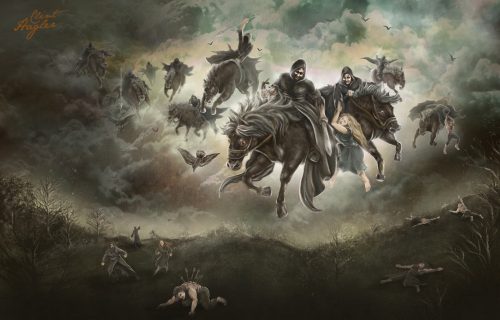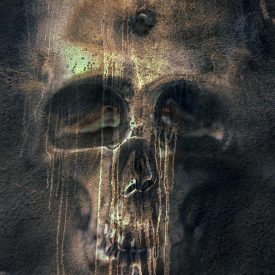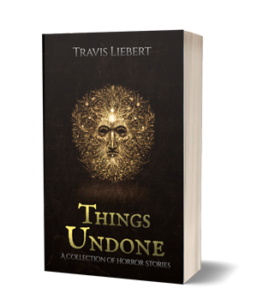

This is the first installment in Horror, Lore, and Darkness, a series of articles about the darker aspects of various folklores, supernatural beliefs throughout the years, and incidents of paranormal phenomena both old and new.
The inspiration for this series came as a result of both my own interests and the research I put into writing my horror stories and books. I’ve always considered folklore and claims of paranormal incidents to be fascinating, and they provide a wonderful foundation for building new stories and mythologies. In particular, I’m currently in the process of writing a new novel, which resulted in me researching various beliefs about ghosts and ways in which to combat them (turns out there’s a helluva lot more than salt and iron).
I found this research interesting and became curious about other folklores and beliefs regarding the supernatural. Additionally, I’m an absolute sucker for accounts of paranormal phenomena, likely as a result of living near Waverly Hills my entire life (which you can read about here). And, being the sort who likes to spew drivel on a page, it was only logical that I began writing about it for my site. But enough of that – let’s get onto the actual article.
The Wild Hunt
The Wild Hunt is actually a bit of folklore that I was largely unfamiliar with until very recently. It’s not something I’ve seen often in media portrayals (although it does appear in Clive Barker’s Coldheart Canyon), but I saw mention of it while reading about European ghost lore.
Historically, the Wild Hunt is a motif that appears in folklore all around Northern Europe and has persisted for centuries. While each region seems to have its own particular spin on the narrative, there are some overarching themes that pervade each culture’s retelling.
In general, the stories always tell of a hunting party that is seen or heard, usually while walking alone at night. However, it’s not just a bunch of 15th-century frat boys (otherwise known as nobles) scurrying around on horses and trying to catch a deer or two. Rather, ghostly apparitions charge by, shouting violently as they race toward some unseen prey. Almost every legend describes them as being accompanied by shadowy barking hounds, and encountering such apparitions usually indicates approaching war, famine, or the individual’s death.
Although the members of the party are usually spirits of some sort, its leader varies depending on cultural context. In some tellings, the Wild Hunt is lead by gods like Odin, while others describe it as being led by the spirit of a former king. Some even claim that the hunt is accompanied by the devil himself, and other biblical figures such as Cain or the angel Gabriel have been described as its leader.
Although there are countless variations on the legend of the Wild Hunt, the story is most well recorded in Britain, Germany, and Scandinavia. Each region has its own themes, so I feel it’s important to note distinctions between these cultures.
The Wild Hunt in Britain
One of the first recorded sightings of a Wild Hunt comes from the report of an English monk named Oderic Vitalis in January of 1091. While living at St. Envroul-en-Ouche, an abbey in Normandy, he claimed to have seen a monk being pursued while traveling the French coast. In his report, Vitalis claims the man was running frantically as a strange group followed close behind. The group was lead by an enormous man wearing a mask and wielding a club. A menagerie of strange figures followed close behind, and they tirelessly stalked the horrified monk. Vitalis provides few other details about the hunt; however, he referred to the eerie group as Harlequin’s Family, and the masked giant was their satanic leader.
Another historic report of a Wild Hunt comes from an early historical document called the Peterborough Chronicle. It relates the story of a small village that recently appointed a new abbot as head of its monastery. Shortly after, the town was plagued with spectral hunters and the sounds of their frenzied pursuit. The report claims that:
“Many men both saw and heard a great number of huntsmen hunting. The huntsmen were black, huge, and hideous, and rode on black horses and on black he-goats, and their hounds were jet black, with eyes like saucers, and horrible. This was seen in the very deer park of the town of Peterborough, and in all the woods that stretch from that same town to Stamford, and in the night the monks heard them sounding and winding their horns.”
A number of witnesses reported this incident, and it’s claimed that this went on for nine weeks. It’s believed that this was punishment for the appointment of their new abbot, as he was considered unfit for the position and lead the monastery with complete negligence.
Over time, countless accounts of Wild Hunts cropped up in Britain. These tended to follow the same general descriptions over and over. However, the purported leader of these hunts changes depending on the time and region. Often witnesses claim that the leader is a recently deceased king, while sometimes he’s claimed to be a long-forgotten nobleman. For centuries, people have claimed to hear the sounds of King Arthur leading his hounds and huntsmen, and these claims have persisted into modern times.
The Wild Hunt in Scandinavia
Scandinavian lore has its own spin on the legend of the Wild Hunt. Like most folklore, the specifics vary from region to region, but there are consistent overarching themes that permeate the myth regardless of location.
In Scandinavian folklore, the Wild Hunt is almost always lead by Odin. While this typically refers to the Norse god as we know him, some small areas maintain that Odin is actually a former nobleman who angered heaven by daring to hunt on Sundays. As a result, he was cursed to hunt supernatural beings until the end of time.
When one encounters this variation of The Hunt, the hunting party almost never appears visually. Instead, the forest grows utterly silent. No wind blows, the birds cease their noise, and even the insects remain still in anticipation of the hunt’s approach. Suddenly, the silence is broken by the sounds of growling dogs punctuated by the occasional whine. One dog barks, then a second follows close behind almost like an echo. These eerie sounds persist until the hunt has passed and Odin seeks his prey elsewhere.
the Wild Hunt in Germany
Of all the variations on the Wild Hunt myth, I find Germany’s to be the most interesting. In particular, the extremely specific detail and almost novelesque quality of these legends contrast sharply with the more general retellings of other regions.
In German folklore, the hunt is lead by a variety of figures, ranging from gods and goddesses to undead nobles and mysterious strangers. In most instances, the hunt is attended by wolves and hounds. Additionally, the accompanying horses can be… a little strange. They’re often depicted with fiery eyes and a varying number of legs, ranging from two all the way to eight. For some reason, of all the creepy things described in these legends, the idea of a two-legged horse freaks me out the most. How does that even work? Is there one leg in the front and another in the back? Is the horse balanced on a pair of legs right in the middle of its body?
Gross.
Anyway, other German legends tell of a man known as the Lone Hunter (Der Wilde Jäger). Rather than the usual circus of howling dogs and frenzied men, the Lone Hunter is silent and foreboding. He rides a black horse, and he’s trailed by a pack of hounds that quietly watch your every movement. He almost never speaks, but when he does, he often reveals that he’s hunting a woman.
When one encounters a Wild Hunt, they usually have two choices: oppose the gathered huntsmen or help them in their quest. If you oppose the hunt, then you will be punished – usually killed or tortured in suitably wretched fashion. However, if you agree to help catch their prey, then you will be rewarded.
This reward sometimes comes in the form of money or other riches. Although, you’ll usually be rewarded with the leg of the slain animal (or human).
What’s that you say? Oh neat, a leg! I’ve always wanted a leg.
A fine response, my friend. After all, who hasn’t dreamed of attaining a warm, succulent leg from a newly slain animal (or human!). However, this delicious reward might not be as awesome as you think. Unfortunately, the leg is usually cursed. In that case, you can’t get rid of it no matter what you do.
There isn’t a lot of detail as to how this is achieved. Does it just follow me wherever I go? Will I open my briefcase during a meeting only to find a warm leg bleeding all over my notes? Or is it more of an Addams family thing? Perhaps the leg hops after you with a mind of its own, oddly adept at navigating staircases and locked doors.
And now I’m thinking of the damn two-legged horse again…
Regardless of how this stalker leg operates, there’s still hope to rid yourself of it. In some cases, you can have a priest or magician remove the curse. But more often, you’ll have to trick the hunting party into taking the leg back. In order to aid in this endeavor, I’ve prepared a short script you can use:
The Seasoning Trap – Act 1, Scene 1
You: Hey, I really appreciate the leg and all. But do you think you could put some salt on this by chance?
Hunter: *Stares at you quizzically.*
You: *Gesture wildly with the leg.*
Hunter: *Takes leg back and begins looking for salt.*
You: *Exit stage left very quickly.*
To Conclude
I suppose that about sums up the important parts of this bit of folklore. Perhaps it’s not the most exciting of legends, but it’s certainly interesting, due in part to its relative obscurity, how widespread the lore is, and the unique details that each culture has attached to their retellings.
I hope you come away from this with two important realizations. First, don’t go walking around forests at night. Second, if someone gives you a leg, don’t accept it the same way you accept the oversized shirts your aunt gifts you every Christmas. Just run away very quickly and hope you don’t hear anything hopping behind you.
Check out Things Undone on Amazon
(Please feed the starving artist. The last thing he ate was a one star review.)
Lovecraft meets modern horror as the world comes undone. All things unknown and unknowable are coming to light…
Strange creatures wander the dark canopies of Germany’s Black Forest.
A young boy harbors something both dark and divine within him.
A man learns to control his dreams, only to find an ancient evil imprisoned within them.
Something lurks in the shadows of a woman’s house, and it wants her baby.
All of these things and more in this riveting new collection of 18 terrifying cosmic and supernatural horror stories. Get it now and discover the terrors that lurk within.







